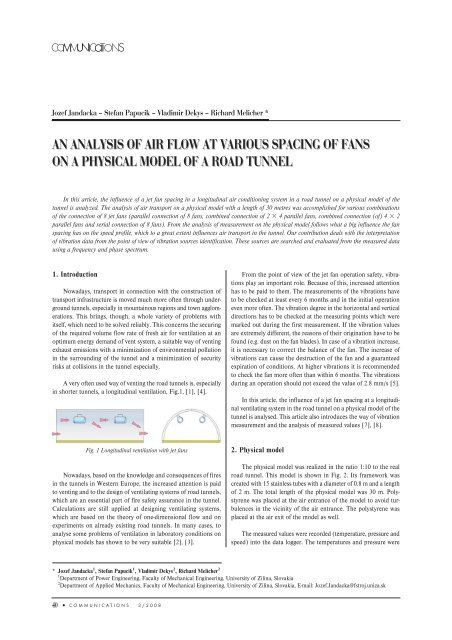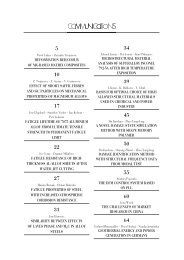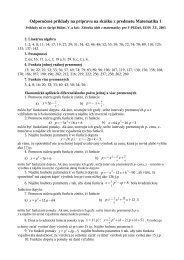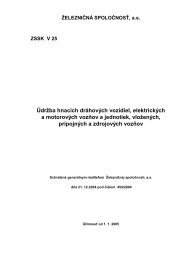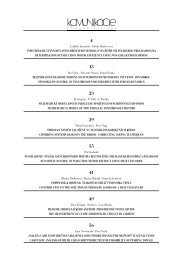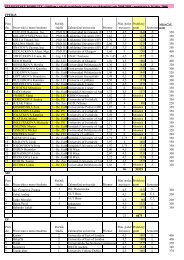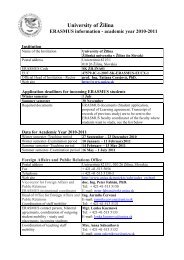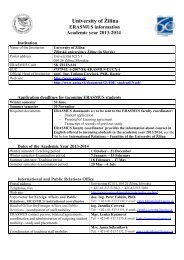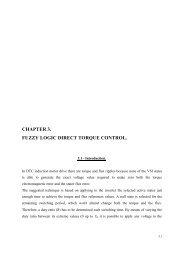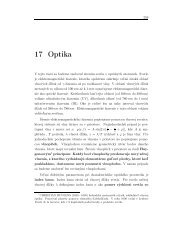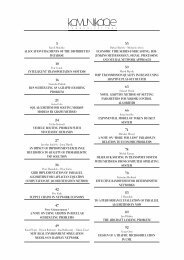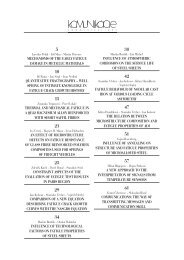simulation of torsion moment at the wheel set of the railway vehicle ...
simulation of torsion moment at the wheel set of the railway vehicle ...
simulation of torsion moment at the wheel set of the railway vehicle ...
You also want an ePaper? Increase the reach of your titles
YUMPU automatically turns print PDFs into web optimized ePapers that Google loves.
Jozef Jandacka – Stefan Papucik – Vladimir Dekys – Richard Melicher *AN ANALYSIS OF AIR FLOW AT VARIOUS SPACING OF FANSON A PHYSICAL MODEL OF A ROAD TUNNELIn this article, <strong>the</strong> influence <strong>of</strong> a jet fan spacing in a longitudinal air conditioning system in a road tunnel on a physical model <strong>of</strong> <strong>the</strong>tunnel is analyzed. The analysis <strong>of</strong> air transport on a physical model with a length <strong>of</strong> 30 metres was accomplished for various combin<strong>at</strong>ions<strong>of</strong> <strong>the</strong> connection <strong>of</strong> 8 jet fans (parallel connection <strong>of</strong> 8 fans, combined connection <strong>of</strong> 2 4 parallel fans, combined connection (<strong>of</strong>) 4 2parallel fans and serial connection <strong>of</strong> 8 fans). From <strong>the</strong> analysis <strong>of</strong> measurement on <strong>the</strong> physical model follows wh<strong>at</strong> a big influence <strong>the</strong> fanspacing has on <strong>the</strong> speed pr<strong>of</strong>ile, which to a gre<strong>at</strong> extent influences air transport in <strong>the</strong> tunnel. Our contribution deals with <strong>the</strong> interpret<strong>at</strong>ion<strong>of</strong> vibr<strong>at</strong>ion d<strong>at</strong>a from <strong>the</strong> point <strong>of</strong> view <strong>of</strong> vibr<strong>at</strong>ion sources identific<strong>at</strong>ion. These sources are searched and evalu<strong>at</strong>ed from <strong>the</strong> measured d<strong>at</strong>ausing a frequency and phase spectrum.1. IntroductionNowadays, transport in connection with <strong>the</strong> construction <strong>of</strong>transport infrastructure is moved much more <strong>of</strong>ten through undergroundtunnels, especially in mountainous regions and town agglomer<strong>at</strong>ions.This brings, though, a whole variety <strong>of</strong> problems withitself, which need to be solved reliably. This concerns <strong>the</strong> securing<strong>of</strong> <strong>the</strong> required volume flow r<strong>at</strong>e <strong>of</strong> fresh air for ventil<strong>at</strong>ion <strong>at</strong> anoptimum energy demand <strong>of</strong> vent system, a suitable way <strong>of</strong> ventingexhaust emissions with a minimiz<strong>at</strong>ion <strong>of</strong> environmental pollutionin <strong>the</strong> surrounding <strong>of</strong> <strong>the</strong> tunnel and a minimiz<strong>at</strong>ion <strong>of</strong> securityrisks <strong>at</strong> collisions in <strong>the</strong> tunnel especially.A very <strong>of</strong>ten used way <strong>of</strong> venting <strong>the</strong> road tunnels is, especiallyin shorter tunnels, a longitudinal ventil<strong>at</strong>ion, Fig.1, [1], [4].From <strong>the</strong> point <strong>of</strong> view <strong>of</strong> <strong>the</strong> jet fan oper<strong>at</strong>ion safety, vibr<strong>at</strong>ionsplay an important role. Because <strong>of</strong> this, increased <strong>at</strong>tentionhas to be paid to <strong>the</strong>m. The measurements <strong>of</strong> <strong>the</strong> vibr<strong>at</strong>ions haveto be checked <strong>at</strong> least every 6 months and in <strong>the</strong> initial oper<strong>at</strong>ioneven more <strong>of</strong>ten. The vibr<strong>at</strong>ion degree in <strong>the</strong> horizontal and verticaldirections has to be checked <strong>at</strong> <strong>the</strong> measuring points which weremarked out during <strong>the</strong> first measurement. If <strong>the</strong> vibr<strong>at</strong>ion valuesare extremely different, <strong>the</strong> reasons <strong>of</strong> <strong>the</strong>ir origin<strong>at</strong>ion have to befound (e.g. dust on <strong>the</strong> fan blades). In case <strong>of</strong> a vibr<strong>at</strong>ion increase,it is necessary to correct <strong>the</strong> balance <strong>of</strong> <strong>the</strong> fan. The increase <strong>of</strong>vibr<strong>at</strong>ions can cause <strong>the</strong> destruction <strong>of</strong> <strong>the</strong> fan and a guaranteedexpir<strong>at</strong>ion <strong>of</strong> conditions. At higher vibr<strong>at</strong>ions it is recommendedto check <strong>the</strong> fan more <strong>of</strong>ten than within 6 months. The vibr<strong>at</strong>ionsduring an oper<strong>at</strong>ion should not exceed <strong>the</strong> value <strong>of</strong> 2.8 mm/s [5].In this article, <strong>the</strong> influence <strong>of</strong> a jet fan spacing <strong>at</strong> a longitudinalventil<strong>at</strong>ing system in <strong>the</strong> road tunnel on a physical model <strong>of</strong> <strong>the</strong>tunnel is analysed. This article also introduces <strong>the</strong> way <strong>of</strong> vibr<strong>at</strong>ionmeasurement and <strong>the</strong> analysis <strong>of</strong> measured values [7], [8].Fig. 1 Longitudinal ventil<strong>at</strong>ion with jet fansNowadays, based on <strong>the</strong> knowledge and consequences <strong>of</strong> firesin <strong>the</strong> tunnels in Western Europe, <strong>the</strong> increased <strong>at</strong>tention is paidto venting and to <strong>the</strong> design <strong>of</strong> ventil<strong>at</strong>ing systems <strong>of</strong> road tunnels,which are an essential part <strong>of</strong> fire safety assurance in <strong>the</strong> tunnel.Calcul<strong>at</strong>ions are still applied <strong>at</strong> designing ventil<strong>at</strong>ing systems,which are based on <strong>the</strong> <strong>the</strong>ory <strong>of</strong> one-dimensional flow and onexperiments on already existing road tunnels. In many cases, toanalyse some problems <strong>of</strong> ventil<strong>at</strong>ion in labor<strong>at</strong>ory conditions onphysical models has shown to be very suitable [2], [3].2. Physical modelThe physical model was realized in <strong>the</strong> r<strong>at</strong>io 1:10 to <strong>the</strong> realroad tunnel. This model is shown in Fig. 2. Its framework wascre<strong>at</strong>ed with 15 stainless tubes with a diameter <strong>of</strong> 0.8 m and a length<strong>of</strong> 2 m. The total length <strong>of</strong> <strong>the</strong> physical model was 30 m. Polystyrenewas placed <strong>at</strong> <strong>the</strong> air entrance <strong>of</strong> <strong>the</strong> model to avoid turbulencesin <strong>the</strong> vicinity <strong>of</strong> <strong>the</strong> air entrance. The polystyrene wasplaced <strong>at</strong> <strong>the</strong> air exit <strong>of</strong> <strong>the</strong> model as well.The measured values were recorded (temper<strong>at</strong>ure, pressure andspeed) into <strong>the</strong> d<strong>at</strong>a logger. The temper<strong>at</strong>ures and pressure were* Jozef Jandacka 1 , Stefan Papucik 1 , Vladimir Dekys 2 , Richard Melicher 21 Department <strong>of</strong> Power Engineering, Faculty <strong>of</strong> Mechanical Engineering, University <strong>of</strong> Zilina, Slovakia2 Department <strong>of</strong> Applied Mechanics, Faculty <strong>of</strong> Mechanical Engineering, University <strong>of</strong> Zilina, Slovakia, E-mail: Jozef.Jandacka@fstroj.uniza.sk40 ● COMMUNICATIONS 3/2008


